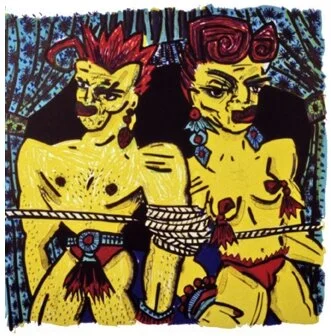M.A.R.S. Legacy
Movimiento Artístico de Rio Salado (M.A.R.S) is the predecessor to Phoenix Institute of Contemporary Art (phICA). M.A.R.S. was founded in 1975 and operated as an art space for 25 years until 2000. With Latino and Native American roots that later included a diverse membership, the artist-run cooperative served Phoenix and the region producing a variety of events, cultural exchanges and artist residencies, and exhibitions including the annual M.A.R.S. Blu-Lite Special sale during the holidays to benefit different community charities and Phoeniquera©, an annual summer exhibition about being living in Phoenix, especially during the harsh summer months. M.A.R.S. had both an artist governing board and a community board. It served as an art organizational model for decades.
Between the years 1985 and 2000, prominent Chicano artists came to Phoenix to participate in an artist-in-residence program which included a solo exhibition at the M.A.R.S. Artspace in Downtown Phoenix and a one-week residency with one of two master printers, John Armstrong, Armstrong-Prior, Inc. and Joe Segura, Segura Publishing Company. From this collaboration, a limited edition, five-color print was produced and made available for sale to benefit M.A.R.S.
The print series has become an important resource for the study of Chicano Art made during the last part of the 20th Century primarily in the Southwestern United States. Prints have been extensively distributed by M.A.R.S./phICA to regional municipalities and university/college collections since 2000.
After the M.A.R.S. Artspace closed, the organization kept functioning under a board of directors which included Eddie Shea (one in the last group of M.A.R.S members), Greg Esser, and Ted Decker who had served on the M.A.R.S. Community Board in the early 1990s. For a decade, the organization focused on Cultural Incubation projects allowing numerous artists and organizations to raise funds with M.A.R.S. serving as a fiscal agent which explains why cultural incubation is an important part of our mission today.
M.A.R.S. legally transitioned to phICA in 2012 after phICA’s first exhibition project in 2011. We value our rich M.A.R.S. legacy in what the organization accomplished during its 35 years in Phoenix and how M.A.R.S. Members diligently built a legacy that continues on with phICA today.
Collections
Arizona State University Art Museum, Tempe, Arizona
Centennial Museum, University of Texas, El Paso, Texas
City of Glendale, Glendale, Arizona
City of Phoenix, Phoenix, Arizona
City of Tempe, Tempe, Arizona
Hispanic Research Center, Arizona State University, Tempe, Arizona
MCC Art Gallery, Mesa Community College, Mesa, Arizona
Mesa Contemporary Arts Museum, Mesa, Arizona
Northern Arizona University Art Museum, Flagstaff, Arizona
Phoenix College Art Collection, Phoenix, Arizona
Phoenix Sky Harbor International Airport Museum, Phoenix, Arizona
Scottsdale Museum of Contemporary Art, Scottsdale, Arizona
The Blanton Museum of Art, University of Texas, Austin, Texas
Tucson Museum of Art, Tucson, Arizona
University of Arizona, Tucson, Arizona
University of Southern Mississippi, Hattiesburg, Mississippi












